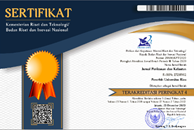Potential of Vanname Shrimp Skin Astanxanthin Hydrolyzate as Alpha Glucosidase Enzyme Inhibitor
(1) Department of Fishery Product Technology, Faculty of Fisheries and Marine, Universitas Riau
(2) Department of Fishery Product Technology, Faculty of Fisheries and Marine, Universitas Riau
(3) Department of Fishery Product Technology, Faculty of Fisheries and Marine, Universitas Riau
(*) Corresponding Author
Abstract
The purpose of the study was to analyze hydrolysate astaxanthin as an inhibitor of the enzyme alf glucosidase. The method used is an experimental method by applying a Complete Random Design (RAL) The treatment used is a concentration of different papain enzymes, consisting of 3 treatment levels namely t1 (3%), t2 (6%), and t3 (9%). Observations made are 1) proximal analysis; 2) analysis of hydrolysate astaxanthin and its antioxidant activity; 3) analysis of the inhibition test of the enzyme alpha glucosidase and its inhibitory mechanism. The results showed that the proxmat of vanname shrimp skin flour is; water content (9.20% bb), ash (31.46% bk), fat (1.64% bk), protein (37.60% bk), and carbohydrates (29.29% bk) (by different) with a yield of 36.22%. The highest astaxanthin content at the 3% papain enzyme concentration of 3.57 μg/g with the best antioxidant activity has the smallest IC50 value of 88,793 ppm and astaxanthin shows inhibition activity of alpha glucoside enzyme by 49.38% - 58.87% and astaxanthin has a competitive enzyme inhibition mechanism resulting in a decrease in postrandial blood glucose levels
Keywords
Full Text:
PDFReferences
[PORIM] Palm Oil Research Institute of Malaysia. (1995). Determination of Color, 109-110. Malaysia.
Bosenberg, L.H. (2008). The Mechanism of Action of Oral Antidiabetic Drugs: A Review of Recent Literature. The Journal of Endocrinolgy, Metabolism and Diabetes of South Africa, 80-88
Chakrabarti, R. (2002). Carotenoprotein from Tropical Brown Shrimp Shell Waste by Enzymatic Process. J Food Biotech, 16(1):81-90.
Davinelli, S., et al. (2018). Short-term Supplementation with Flavanol-Rich cocoa Improves Lipid Profile, Antioxidant Status and Positively Influences the AA/EPA Ratio in Healthy Subjects. Journal of Nutritional Biochemistry, 61(3):33–39. doi: 10.1016/j.jnutbio.2018.07.011
Desiana. (2000). Hidrolisissi Pigmen Karotenoid dari Limbah Kulit Udang Windu (Penaeus monodon Fabricus) dengan Bantuan Enzim Papain. Skripsi. Fakultas Perikanan dan Ilmu Kelautan IPB: Bogor.
Karnila, R., Heriansyah, I. (2020). Astaxanthin. Riau: Oceanum Press
Karnila, R., Made., Sukarno, S., Tutik, W. (2011). Analisa Kandungan Nutrisis Daging dan Tepung Teripang Pasir (Holothuria scabra J) Segar. Jurnal Terubuk, 39(2), 51-52
Mansjoer, A., et al. (2000). Kapita Selekta Kedokteran. Edisi 3. Jakarta: Media
Sadeli, R.A. (2016). Antioxidant Activity Test using the DPPH(1,1-diphenyl-2-phicrylhydrazyl) Bromelain Extract of Pineapple Fruit (Ananas comosus) (L.) Merr.). Satana Darma University. Faculty of Pharmacy. Yogyakarta.
Sugiwati, S., Setiasih, S., Afifah, E. (2009). Antihyperglycemic Activity of the Mahkota Dewa [Phaleria macrocarpa (Scheff.) Boerl.] Leaf Extracts as a α-Glucosidase inhibitor. Makara Health, 13(2):74-78
Article Metrics
Abstract view : 44 timesPDF - 33 times
DOI: http://dx.doi.org/10.31258/jpk.28.3.367-371
Copyright (c) 2023 Ivan Heriansyah, Rahman Karnila, Dewita Buchari

This work is licensed under a Creative Commons Attribution-NonCommercial-NoDerivatives 4.0 International License.
Gedung Marine Center Lt 2. Fakultas Perikanan dan Kelautan Universitas Riau



